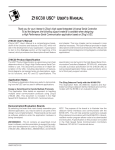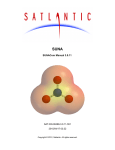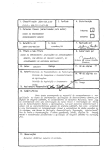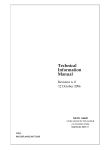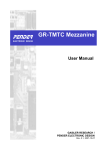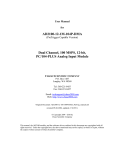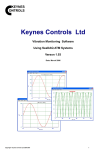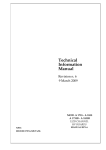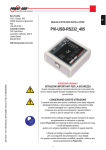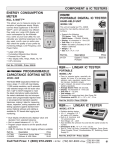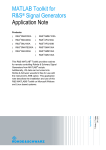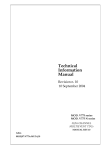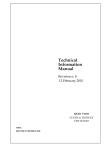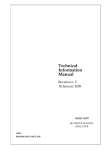Download V1729A User Manual
Transcript
Technical
Information
Manual
Revision n. 3
26 February 2010
MOD. V1729A
4 CHANNEL/14BIT
SAMPLING ADC
MANUAL REV.3
NPO:
00101/08:1729A.MUTx/03
CAEN will repair or replace any product within the guarantee period if the Guarantor declares
that the product is defective due to workmanship or materials and has not been caused by
mishandling, negligence on behalf of the User, accident or any abnormal conditions or
operations.
CAEN declines all responsibility for damages or
injuries caused by an improper use of the Modules due
to negligence on behalf of the User. It is strongly
recommended to read thoroughly the CAEN User's
Manual before any kind of operation.
CAEN reserves the right to change partially or entirely the contents of this Manual at any time
and without giving any notice.
Disposal of the Product
The product must never be dumped in the Municipal Waste. Please check your local
regulations for disposal of electronics products.
PRELIMINARY
Document type:
User's Manual (MUT)
Title:
Mod. V1729A 4 Channel 14 Bit Sampling ADC
Revision date:
26/02/2010
Revision:
3
TABLE OF CONTENTS
1.
DESCRIPTION OF V1729A BOARD.........................................................................................................5
1.1
1.2
1.3
2.
GENERALITIES. DESCRIPTION OF THE OVERALL FUNCTIONALITY .............................................................5
SAMPLING FREQUENCY ............................................................................................................................5
INPUT SIGNALS & DYNAMIC RANGE .........................................................................................................6
MODE OF OPERATION.............................................................................................................................7
2.1
DEFINITION OF THE ACQUISITION WINDOW & TRIGGER MODES ................................................................7
2.1.1
Principle, PRETRIG, POSTTRIG....................................................................................................7
2.1.2
Trigger sources................................................................................................................................8
2.1.3
Trigger edge ....................................................................................................................................8
2.1.4
TRIGOUT signal .............................................................................................................................8
2.1.5
Validation of the trigger by a second subsequent signal.................................................................9
2.2
DEAD TIME AT THE START OF THE ACQUISITION; PRETRIG ......................................................................10
2.3
STANDARD ACQUISITION SEQUENCE .......................................................................................................10
2.3.1
Acquisition started by user ............................................................................................................10
2.3.2
Automatically restarted acquisition...............................................................................................12
2.4
CORRECTION OF DATA ............................................................................................................................12
2.4.1
Correction of the pedestals............................................................................................................12
2.4.2
Temporal corrections ....................................................................................................................13
2.5
FUNCTIONING WITH TWO 5K OR ONE 10K-CHANNEL ...............................................................................15
3.
SYNCHRONIZATIONS, CALIBRATIONS, MONITORING ..............................................................16
3.1
SYNCHRONIZATION BETWEEN THE CHANNELS ........................................................................................16
3.1.1
Channels from the same board......................................................................................................16
3.1.2
Channels situated on different boards..........................................................................................16
3.2
SYNC_OUT AND BUSY SIGNALS. PARTIAL READING OF MATRICES .....................................................16
3.3
CALIBRATIONS .......................................................................................................................................17
3.3.1
Calibration of the interpolator ......................................................................................................17
3.3.2
Calibration of the pedestals...........................................................................................................19
3.3.3
Temporal calibration between different channels .........................................................................19
3.4
TRIGGER RATE MONITOR ........................................................................................................................19
4.
TECHNICAL DESCRIPTION ..................................................................................................................21
4.1
MECHANICAL AND ELECTRICAL STANDARDS..........................................................................................21
4.1.1
Mechanical standard .....................................................................................................................21
4.1.2
Electrical interfaces.......................................................................................................................21
4.1.3
Summary of front panel signals.....................................................................................................22
4.1.4
Supplies .........................................................................................................................................23
4.1.5
Pinout of the non-standard connectors .........................................................................................23
4.1.6
Straps and resistor network sockets ..............................................................................................24
4.1.7
Implementation of differential inputs ............................................................................................24
4.2
INTERFACES. VME INTERFACE...............................................................................................................25
4.2.1
GPIB Interface...............................................................................................................................25
4.2.2
USB Interface. ...............................................................................................................................26
4.3
DEALING WITH THE MEMORIES...............................................................................................................26
4.3.1
Reading of the data in the RAM; mapping. ...................................................................................26
4.3.2
Accessing the EEPROM ................................................................................................................28
4.4
LIST OF THE SUB-ADDRESSES..................................................................................................................28
4.5
SYNOPSIS OF THE BOARD ........................................................................................................................35
5.
SPECIFICATIONS AND PERFORMANCES.........................................................................................37
NPO:
00101/08:1729A.MUTx/03
Filename:
V1729A_REV3.DOC
Number of pages:
44
Page:
3
PRELIMINARY
Document type:
User's Manual (MUT)
5.1
Title:
Mod. V1729A 4 Channel 14 Bit Sampling ADC
Revision date:
26/02/2010
Revision:
3
FRONT PANEL .........................................................................................................................................38
6.
BIBLIOGRAPHY .......................................................................................................................................39
7.
APPENDIX - USING THE ROTATING MASKS ...................................................................................40
7.1
WORKING PRINCIPLE ..............................................................................................................................40
7.1.1
Example of working at 500 MS/s...................................................................................................41
LIST OF FIGURES
FIG. 1.1: DATA FLOW IN THE BOARD .....................................................................................................................5
FIG. 2.1: CHRONOGRAM OF THE STOPPING OF THE ACQUISITION ...........................................................................7
FIG. 2.2: CENTERING OF THE TRIGGER IN ACQUISITION WINDOW FOR TWO POSTTRIG CASES.............................7
FIG. 2.3: SIMPLIFIED DESCRIPTION OF THE TRIGGER SELECTION CHAIN .................................................................9
FIG. 2.4: SIMPLIFIED DESCRIPTION OF THE TRIGGER VALIDATION SYSTEM ..........................................................10
FIG. 2.5: BLOCK DIAGRAM OF A STANDARD ACQUISITION ...................................................................................11
FIG. 2.6: SCANNING OF INTERRUPTION REGISTER OR TREATMENT OF ASYNCHRONOUS INTERRUPTION ...............13
FIG. 2.7: UNFOLDING OF THE CIRCULAR MEMORY...............................................................................................14
FIG. 3.1: DIAGRAM OF THE CALIBRATION OF THE VERNIERS ...............................................................................18
FIG. 3.2: TRIGGER RATE MONITOR ......................................................................................................................20
FIG. 4.1: CONNECTORS AND CONFIGURATION ELEMENTS ON V1729A................................................................21
FIG. 4.2: COMPONENTS POSITION .......................................................................................................................25
FIG. 4.1: SYNOPSIS OF THE V1729A BOARD .......................................................................................................35
FIG. 4.2: SYNOPSIS OF AN ACQUISITION CHANNEL ON THE BOARD ......................................................................36
FIG. 5.1: V1729A FRONT PANEL ........................................................................................................................38
FIG. 7.1: WORKING PRINCIPLE OF THE BOARD (PATENTED) .................................................................................40
FIG. 7.2: STATE OF THE MATRIX AT THE BEGINNING ...........................................................................................41
FIG. 7.3: STATE OF THE MATRIX AFTER THE CROSSING OF COLUMN 2 .................................................................42
FIG. 7.4: STATE OF THE MATRIX AFTER THE CROSSING OF COLUMN 66 ...............................................................42
FIG. 7.5: STATE OF THE MATRIX AFTER THE 2ND CROSSING OF COLUMN 2............................................................43
FIG. 7.6: STATE OF THE MATRIX AFTER THE 2ND CROSSING OF COLUMN 66..........................................................43
FIG. 7.7: STATE OF THE MATRIX AFTER THE 4TH CROSSING OF COLUMN 2 ............................................................44
FIG. 7.8: STATE OF THE MATRIX AT THE END OF THE FILLING UP.........................................................................44
NPO:
00101/08:1729A.MUTx/03
Filename:
V1729A_REV3.DOC
Number of pages:
44
Page:
4
PRELIMINARY
Document type:
User's Manual (MUT)
Title:
Mod. V1729A 4 Channel 14 Bit Sampling ADC
Revision date:
26/02/2010
Revision:
3
1. Description of V1729A board
1.1
Generalities. Description of the overall functionality
-
-
-
The V1729A board is suited for acquisition of fast analog signals based on the MATACQ
(analog matrix) chip [1] developed by collaboration of the CEA/DAPNIA and the
l’IN2P3/LAL. This board, in the mechanical format 1-unit wide VME 6U board, is
compatible with several standards of acquisition (VME A32/D64, A32/D32, A24/D16,
GPIB and USB 2.0).
It is an evolution of the 12-bit dynamic range board series, and is compatible with the
latter at power-up: it thus can be used by default with the same software.
It performs the coding of 4 analog channels of bandwidth tunable up to 300MHz over 14
bits at a sampling frequency (Fe) tunable up to 2GHz and over a depth of 2520 usable
points. The channels can be grouped if needed in order to increase the sampling depth.
The measurement is realized in three phases (see Fig 1.1):
Acquisition :
the analog signal is continuously sampled at the frequency Fe in a circular analog
memory. The arrival of a trigger signal initiates the stopping phase of the sampling, see
2.1.1. At the end of this phase, the state of the memory is set: it then contains the last
2560 points sampled (out of which 2500 are valid).
Conversion and storage :
after a stopping order of the acquisition, the samples stored under analog form in the
MATACQ chips are rapidly (650µs) re-read and coded into digital data over 14 bits, then
stored in a digital memory buffer. The acquisition is informed of the end of the coding
phase either by scanning of an internal register, or by an interruption.
Reading :
the memory buffer can then be re-read by the acquisition system. For an acquisition
system of VME A24-D16 standard, the latter operation lasts a few ms for the full readout
of a 4-channel board, which permits attaining an acquisition frequency of a few hundred
Hz for the acquisition of 2500 points per channel. With a high performance A32-D32
system, one should pass 500Hz, and approach the kHz with a performing A32/D64
system.
Fig. 1.1: data flow in the board
1.2
Sampling frequency
The V1729A board is sequenced by an oscillator at a frequency of 100MHz. No greater
frequency signal exists on the board. This is what explains the low consumption of the
system. The sampling at a very high frequency (Fe) in the MATACQ chip is in fact
realized by virtual multiplication of frequency inside the chip by a factor up to 20.
NPO:
00101/08:1729A.MUTx/03
Filename:
V1729A_REV3.DOC
Number of pages:
44
Page:
5
PRELIMINARY
Document type:
User's Manual (MUT)
Title:
Mod. V1729A 4 Channel 14 Bit Sampling ADC
Revision date:
26/02/2010
Revision:
3
The MATACQ chip functions with a pilot frequency of 50MHz or 100MHz programmable
on the board by software, which corresponds to a sampling frequency Fe (= 20*Fp) of 1
or 2 GHz. The EXT_CLK input may possibly be used to inject a very clean external pilot
clock comprised between 50MHz and 100MHz. Caution: the MATACQ chip cannot work
properly with a pilot frequency Fp lower than 50MHz.
1.3
Input signals & Dynamic range
The V1729A board integrates 4 analog channels. Depending on the different versions,
the inputs of these channels are connected through simple LEMO plugs (IN0 to IN3),
double (IN0± to IN3±), or SMA plugs (IN0 to IN3).
The inputs are by default unipolar and terminated on 50 Ohms. However, the input levels
of the board can be very easily modified (through displacing a few resistors and mounting
new ones) in such a way as to permit the input in differential mode (from which the
possibility of mounting double LEMO plugs). For this purpose, free CMS-805 resistor
footprints are indeed implemented on the V1729A board (see section 4).
The analog to digital conversion is made on 14 bits with a maximum dynamic range of
2V, or an LSB of 125µV. This range is centred on 0V (± 1V). However, free CMS-805
footprints are implemented on the V1729A board for shifting the dynamic range in the
interval ± 0.5V in order to be able to optimize the system for unipolar signals (see 4.1.8).
The measured noise referred to input is less than 175 µV RMS, and the integral nonlinearity remains below 1 per 1000 over the whole dynamic range.
NPO:
00101/08:1729A.MUTx/03
Filename:
V1729A_REV3.DOC
Number of pages:
44
Page:
6
PRELIMINARY
Document type:
User's Manual (MUT)
Title:
Mod. V1729A 4 Channel 14 Bit Sampling ADC
Revision date:
26/02/2010
Revision:
3
2. Mode of operation
2.1
Definition of the acquisition window & Trigger modes
2.1.1
Principle, PRETRIG, POSTTRIG
During the acquisition, the analog signal is continuously sampled in the analog memory
which is comparable to a circular buffer with a depth of 2560 points (time depth =
2560/Fe). The stopping of sampling is initiated by the arrival of a trigger signal Ta
(asynchronous trigger) which is common to all the channels of a board. This signal is
only authorized to be produced following a programmable delay named PRETRIG after
the triggering of the acquisition sequence.
The effective stopping of the sampling will occur following a pre-defined number (named
POSTTRIG) of clock periods (50MHz or 100MHz) after the trigger (see Fig 2.1).
The POSTTRIG, programmable by the user, permits defining and displacing the position
of the trigger signal in the acquisition window. It is adjustable in the 1/Fp to 65535/Fp
range by steps of 1/Fp ( = 20ns or 10ns), to which a fixed extra offset of 7/Fp has to be
added. This is illustrated in Fig 2.2.
Fig. 2.1: chronogram of the stopping of the acquisition
In the example illustrated by Fig 2.1, the total POSTTRIG is fixed at 13/Fp (6/Fp
programmed in the register + 7/Fp extra offset). The acquisition will be stopped 13/Fp + ti
after the arrival of the trigger signal (ti corresponds to the time measured by the vernier
between the Ta and the next rising edge of the clock – see 2.4.2). The analog memory
will then contain the 2560 last recorded samples (of which only the last 2520 after realignment will be exploited).
Fig. 2.2: centering of the Trigger in acquisition window for two POSTTRIG cases
Thus, a POSTTRIG value close to 64 assures the centering of the trigger in the middle of
the acquisition window. For the values of POSTTRIG > 118, the trigger position no longer
appears in the acquisition window.
NPO:
00101/08:1729A.MUTx/03
Filename:
V1729A_REV3.DOC
Number of pages:
44
Page:
7
PRELIMINARY
Document type:
User's Manual (MUT)
Title:
Mod. V1729A 4 Channel 14 Bit Sampling ADC
2.1.2
Revision date:
26/02/2010
Revision:
3
Trigger sources
There exist four possible sources for the trigger signal Ta. They are selectable by the
user (see 4.4):
-
Trigger on signal : this is the result of the logic « OR » of the discriminators
on the analog signals of one or several channels of the board by choice of the
user. The individual thresholds of the discriminators are programmable by
steps of 0.5mV (12-bit DACs) over a range of ± 1V (which corresponds to the
integrality of the usable input range of the board). The user can also define
the type of discrimination (signal crossing the threshold upwards or
downwards) via the choice of the trigger edge.
-
External trigger : external trigger signal entering on a LEMO plug
(EXT_TRIG signal at the NIM level). This signal can be either used as any
other trigger source with choice of its edge, or exploited directly as an
asynchronous trigger (rising edge only) in cases where one uses
discriminators from several boards in order to produce at the exterior of the
boards (via their output TRIG_OUT) a trigger which will be sent back to them
in a synchronous way (see figure 2.3). This mode is selected by the bit 4 of
the TRIG_TYPE register (see 4.4).
-
Auto trigger : triggered by a software command issued from the acquisition.
It permits the generation of a random trigger. This corresponds to the
automatic trigger mode.
-
« Auto + normal » trigger : result of a logic « OR » between the trigger on
signal and the automatic trigger.
-
Internal random trigger : this internal periodic signal is asynchronous from
the clock. When it is selected and the trigger mode chosen is « auto », this
signal serves as a source for the automatic trigger. One uses it for the fast
calibration of the verniers of the MATACQ chips (see 3.3.1).
2.1.3
Trigger edge
The trigger edge (rising or falling) can be selected in all modes (except the direct external
trigger which uses only the rising edge).
2.1.4
TRIGOUT signal
A copy of the pre-trigger signal (positive pulse) generated by the V1729A board is
available at the output on a LEMO plug on the front panel (TRIG_OUT output on the NIM
level). It can in particular permit synchronization of trigger for several boards.
A simplified summary of the trigger modes of the board is presented in figure 2.3.
NPO:
00101/08:1729A.MUTx/03
Filename:
V1729A_REV3.DOC
Number of pages:
44
Page:
8
PRELIMINARY
Document type:
User's Manual (MUT)
Title:
Mod. V1729A 4 Channel 14 Bit Sampling ADC
Revision date:
26/02/2010
Revision:
3
Fig. 2.3: simplified description of the trigger selection chain
2.1.5
Validation of the trigger by a second subsequent signal
In the case where one would like to validate the data stored in the MATACQ chips before
their transfer towards the RAM, it is possible to make use of the EXT_EN_TRIG input to
introduce there through a validation signal (see figure 2.4). This is particularly useful if
the system produces such a signal with a delay greater than the maximum sampling
depth (2560/Fp i-e 1.25µs at 2GS/s and 2.5µs at 1GS/s) and smaller than the transfer
time towards the RAM (675µs). This can thus permit a big decrease of the potential
dead-time linked to the readout. In this case, the usual use of the EXT_EN_TRIG signal
(which permits inhibiting the trigger as described on figure 2.3) is inhibited.
In order to perform the validation, a programmable 8-bit latency counter (called
POST_STOP_LATENCY) with steps of 2.5µs is started at the end of the POSTTRIG,
and if the external validation signal hasn’t arrived before the end of that delay, the
Matacq chips switch back into the analog input signal writing mode thus waiting for the
next trigger. If on the other hand the validation signal did arrive, the waiting data is
digitized then stored into the RAM. This mode is validated thanks to the bit 5 of the
TRIGGER_TYPE register (see 4.4). Moreover, a second 8-bit register (called
POST_LATENCY_PRETRIG) with the same steps of 2.5µs permits the programming of
the time to wait before enabling the trigger again if the validation didn’t occur. The
minimum time for refilling is of 1.25µs at 2GS/s and of 2.5µs at 1GS/s. The minimum
value in that register is thus 1.
NPO:
00101/08:1729A.MUTx/03
Filename:
V1729A_REV3.DOC
Number of pages:
44
Page:
9
PRELIMINARY
Document type:
User's Manual (MUT)
Title:
Mod. V1729A 4 Channel 14 Bit Sampling ADC
Revision date:
26/02/2010
Revision:
3
Fig. 2.4: simplified description of the trigger validation system
2.2
Dead time at the start of the acquisition; Pretrig
The frequency of the clock present on the board is relatively low (50MHz or 100MHz). In
order to be able to sample at a rate equal to or greater than the Giga-sample per second,
the MATACQ chips realize a virtual multiplication of frequency. This multiplication
requires a servo of which the control loop is interrupted at the time of the data read cycle.
At the time of the start of the acquisition, this servo has to get locked again. This
implicates a typical waiting of 150µs before being able to reach the optimum of the
sampling performances.
For this reason, at each restarting of the acquisition, the board must automatically
generate a dead time during which the triggers are not accepted.
This dead time is adjustable by the PRETRIG, from 1 to 65535 times the period of the
main clock. The recommended PRETRIG values are therefore :
• 7500 (decimal) for a clock frequency of Fp = 50MHz.
• 15000 (decimal) for a clock frequency of Fp = 100MHz.
2.3
Standard acquisition sequence
2.3.1
Acquisition started by user
Fig 2.4 shows the standard course of an acquisition :
- The sequence begins with the initialization of the board by a RESET
order.
NPO:
00101/08:1729A.MUTx/03
Filename:
V1729A_REV3.DOC
Number of pages:
44
Page:
10
PRELIMINARY
Document type:
User's Manual (MUT)
Title:
Mod. V1729A 4 Channel 14 Bit Sampling ADC
Revision date:
26/02/2010
Revision:
3
- Next, the different parameters which are not used with their default value
must be programmed (PRETRIG, POSTTRIG, TRIGGER TYPE,
TRIGGER EDGE, MASK, NB OF COL TO READ, FP FREQUENCY, …).
- The starting order of the acquisition is next sent (START_ACQUISITION).
The latter can also be generated automatically (see 3.3.2).
- The user if necessary sends a software trigger (in the case of an
automatic trigger) having taken care to wait at least the time necessary for
the PRETRIG.
- The program then waits for a request emitted by the V1729A board when
the data are ready to be read. For this, there exist two possibilities illustrated
by Fig 2.5 :
• Waiting and handling of an interruption (SRQ in GPIB, IRQ1 to 7 in
VME, specific format in USB).
• Regular scanning of the LSB of the interruption register (INTERRUPT
h80).
The first solution has the big advantage of being less noisy for the front-end
of the board for it does not require any bus access. In both cases, the user
should acknowledge the request by writing a 0 in the INTERRUPT register,
but the latter is anyhow reset by the START_ACQ command.
- The user can then partially or wholly read the data stored in the board.
This includes :
the values of the vernier and of the samples (see 3.3.1)
the value of TRIG_REC which permits determination of the position of the
trigger in the acquisition window (see 4.3.2)
NPO:
00101/08:1729A.MUTx/03
Filename:
V1729A_REV3.DOC
Number of pages:
44
Page:
11
PRELIMINARY
Document type:
User's Manual (MUT)
Title:
Mod. V1729A 4 Channel 14 Bit Sampling ADC
Revision date:
26/02/2010
Revision:
3
Fig. 2.5: block diagram of a standard acquisition
- The user must correct the data before using it (see 2.4):
• By subtracting the pedestals (see 2.1.1).
• By reordering the data (see 2.4.2).
These operations can be executed on-line or off-line according to the
context.
2.3.2
Automatically restarted acquisition
In order to reduce the dead-time due to the restarting of the acquisition, an automatic
mode has been implemented on the board. Its use is conditioned to the bit 2 of the
MODE_REGISTER (see 4.4) which is set to 0 by default. The working principle is the
following :
when this bit is set to 1, one has to perform the first acquisition in a usual way via the
START_ACQUISITION command. At the end of the latter, it is necessary to read at least
one of the three registers TRIG_REC, Valp_cp and Vali_cp in the RAM (see 4.3.2).
During the reading in the RAM of any of those, a START_ACQUISITION command is
generated automatically. Caution : if one wants to read the three of them, one disposes
then of the PRETRIG duration to read the two last ones. Reading the RAM after the end
of the PRETRIG may indeed pollute the analog data of the new starting acquisition
sequence.
In order to leave this mode, one just has to reset the bit 2 of the MODE_REGISTER.
NPO:
00101/08:1729A.MUTx/03
Filename:
V1729A_REV3.DOC
Number of pages:
44
Page:
12
PRELIMINARY
Document type:
User's Manual (MUT)
Title:
Mod. V1729A 4 Channel 14 Bit Sampling ADC
Revision date:
26/02/2010
Revision:
3
Caution : one has to take care of not « forgetting » the board running in this mode
without trigger occurring for it then remains blocked in acquisition state, thus with the
maximum power consumption.
2.4
Correction of data
•
•
The raw data extracted from the board must be treated before really being usable.
This treatment consists of two operations :
Correction of the pedestals.
Reordering and time alignment of the data.
2.4.1
Correction of the pedestals
The analog memories of the MATACQ chips present by design dispersions of pedestal
from cell to cell which can reach several tens of mV. On the other hand, the pedestal of a
data cell is extremely reproducible (250µV RMS). Due to the structure of the chip, the
dispersion of the pedestals presents a principal periodicity of 20 cells, followed by a tiny
individual distribution. If not compensated, this dispersion will appear as a noise at the
reconstruction of the signal because of the random position of the trigger in the matrix.
Fig. 2.6: scanning of interruption register or treatment of asynchronous interruption
In order to obtain the nominal noise performances (signal to noise ratio of 81dB), the
pedestals, which are stable in time and with temperature, must be removed by the
acquisition software individually cell by cell. As discussed above, it is also possible to
subtract 128 times a pattern of 20 cells. This makes it possible to store only 20
pedestals, and the loss of the signal over noise ratio remains minor (approximately 1 to
2dB) even though it is not negligible.
Since the pedestal of a cell is linked to its physical location and not to its position in
relation to the Trigger, it is necessary to realize this removal BEFORE reordering the
data.
A method of calibration of the pedestals is demonstrated in section 3.3.
NPO:
00101/08:1729A.MUTx/03
Filename:
V1729A_REV3.DOC
Number of pages:
44
Page:
13
PRELIMINARY
Document type:
User's Manual (MUT)
2.4.2
Title:
Mod. V1729A 4 Channel 14 Bit Sampling ADC
Revision date:
26/02/2010
Revision:
3
Temporal corrections
The signal is sampled in a circular memory. The first operation necessary for the
treatment of the data is therefore to « unfold » the circular memory of every channel in
order to obtain tables of 2560 temporally ordered data (see Fig 2.7). This can be done,
by example, by realizing a rotation of :
(1) ROT = (TRIG_REC - POSTTRIG ) * 20
cells towards the left of the data tables issued from the RAM and formerly sorted channel
by channel (see 4.3).
Fig. 2.7: unfolding of the circular memory
Or, equivalently through a calculation of a new index number for each data :
(2) NEWi = (2560 + OLDi – END_CELL) modulo 2560
where END_CELL is the index of the last written cell :
END_CELL = 20 * (POSTTRIG +128- TRIG_REC) modulo128
The trigger signal TRIGA (asynchronous trigger) is the absolute reference which
serves to temporally realign the data (see Fig2.1). In order to find its position, one
uses the information provided by a temporal interpolator (vernier) measuring ti, time
interval separating the arrival of TRIGA from the next rising edge of the Fp clock.
This information associated with the MINVER and MAXVER calibration constants
(see 3.3.2) permits determination of the position of the Trigger and therefore
realignment of the data with a typical maximum precision in the region of 50ps RMS.
This realignment is unnecessary if the user simply desires to study the signal shape
and in this case, the curve acquired will present a jitter of a period of Fp. The
information of the 4 verniers from the same board being redundant in order to realize
the temporal adjustement, it is therefore possible:
- to use solely the vernier from the channel 0.
NPO:
00101/08:1729A.MUTx/03
Filename:
V1729A_REV3.DOC
Number of pages:
44
Page:
14
PRELIMINARY
Document type:
User's Manual (MUT)
Title:
Mod. V1729A 4 Channel 14 Bit Sampling ADC
Revision date:
26/02/2010
Revision:
3
- to use the vernier i for the channel i.
- to calculate the mean of the 4 verniers in order to refine the time precision.
The following formula permits determination of the time of each point of the reordered
table, with by convention a time origin (Time = 0) at the arrival of the Trigger.
(3) Time[NEWi] = DT0 + {NEWi - 20 *[128 - POSTTRIG + Correc_Ver]} * dT
With (4) Correc_Ver = (VERNIER - MINVER) / (MAXVER - MINVER)
Where
:
dT is the sampling period (500ps or 1ns)
DT0 is a fixed temporal offset, close to 0, due to signal propagation times in the
board (of which the calibration is described in 3.1.1
An alternative but equivalent solution, consists in generating the reordered table
through a rotation towards the left of the data of :
(1b) ROT = (TRIG_REC - POSTTRIG ) * 20 – INT(Correc_Ver*20) cells
where INT corresponds to rounding off to the nearest whole number.
The trigger is then situated at a time
(5) tT= [Correc_Ver*20– INT(Correc_Ver*20)]* dT
before the cell numbered 20*(128-POSTTRIG) (plus the offset DT0).
2.5
Functioning with two 5k or one 10k-channel
The V1729A board permits grouping either 2 x 2 or the 4 channels of the board in order
to increase the sampling depth. One then has to inject the same signal into the front
panel on the inputs of the concerned channels. In this case, a complement of POSTTRIG
will be added automatically in order to fill up the supplementary depth. It will depend on
the number of grouped channels and of the chosen sampling frequency Fe. Trigger will
always be located within the first 2520 points or before (depending on the POSTTRIG).
Grouping
of channels
4x1
2x2
1x4
POSTTRIG
in samples
Normal (as programmed)
Normal + 2520
Normal + 3 x 2520
POSTTRIG
in time
Normal (as programmed)
Normal + 2520/Fe
Normal + 3x2520/Fe
There may be a slight difference in time and in gain between channels. In order to
calibrate the gain difference, a continuous voltage set at the three quarters of the full
scale for both polarities is recommended. Concerning the time offset, a calibration using
a voltage ramp might be necessary. The last points of the first channel will be compared
to the first of the following one, and so on if more than two channels are concerned.
NPO:
00101/08:1729A.MUTx/03
Filename:
V1729A_REV3.DOC
Number of pages:
44
Page:
15
PRELIMINARY
Document type:
User's Manual (MUT)
Title:
Mod. V1729A 4 Channel 14 Bit Sampling ADC
Revision date:
26/02/2010
Revision:
3
3. Synchronizations, calibrations, monitoring
3.1
Synchronization between the channels
3.1.1
Channels from the same board
A single trigger signal is used for all of the channels from the same board. The
acquisition of these channels will therefore naturally be synchronous, with a typical jitter
of only 20ps RMS. The possible temporal offset dT0, constant, between the channels
(principally due to the propagation of the trigger signal on the board, but also to the
different lengths of cables at the inputs) will be calibrated once for all. This calibration is
executed by sending a same signal on all of the inputs and by looking for the fine position
of the trigger on each of the channels.
In the case where the board is triggered on one of the input signals, a fine
synchronisation method consists of interpolating by software the crossing of the signal
through the trigger threshold on the given channel, this permitting the fine datation of all
the measured channels.
3.1.2
Channels situated on different boards
The synchronization is only possible if the trigger source is common to the different
boards. For this, several possibilities can be envisaged :
- to use an external trigger signal common to all of the boards.
- to generate the trigger signal on a fixed board (master) which triggers itself and
to send its TRIG_OUT signal output to the external trigger input of the other boards (via a
NIM buffer if there is more than one target board).
- to generate the trigger signal on any one of the boards. The TRIG_OUT outputs
of all of the boards will then be connected on an external NIM logic then the result will be
redistributed in a synchronous fashion to all the boards via their EXT_TRIG input. It is
this latter input which will then be programmed as the source of the asynchronous trigger
via the bit 4 of the TRIGGER_TYPE register on all the boards.
In all cases a calibration of the temporal offset between the boards is necessary. This
calibration, similar to that which is necessary to align the channels from the same board,
will be dependent upon the set-up (length of the cables…).
3.2
SYNC_OUT and BUSY signals. Partial reading of matrices
One of the NIM outputs of the front panel can be configured either as a SYNC_OUT, or
as a BUSY respectively with the help of the S4 and S2 straps. SYNC_OUT is a
synchronization signal corresponding to the writing in the first cell of the second column
of the circular analog memory, and which can be made available on the front panel. For
certain applications, this signal can permit triggering of the source analog signals and
thus guaranties their fixed position in the memory. Thus, if the temporal occupation of the
signals to acquire is low, the user will have the possibility to only re-read the beginning of
the depth of the analog memory and to thus limit the dead time linked to the acquisition.
NPO:
00101/08:1729A.MUTx/03
Filename:
V1729A_REV3.DOC
Number of pages:
44
Page:
16
PRELIMINARY
Document type:
User's Manual (MUT)
Title:
Mod. V1729A 4 Channel 14 Bit Sampling ADC
Revision date:
26/02/2010
Revision:
3
BUSY is a signal destined to inform the external world that the board is not ready to
receive a signal (it is either idle, or in the process of transferring data between the
MATACQ chips and the RAM, or at the beginning of the acquisition phase). Its transition
to 0 indicates then that the board is now ready to record a signal.
Calibrations
3.3
In order to attain the optimal metrological performance, the V1729A board requires
calibrations. These remain valid for several weeks, even several months. The
corresponding data can thus be memorized for each acquisition mode. To this end, a
128kBytes EEPROM is available on the board.
3.3.1
Calibration of the interpolator
The temporal interpolator (vernier) requires a calibration. This operation will be
necessary following all changes in the sampling frequency. Once performed, its result
will be able to get stored and re-used. This calibration, based on a statistical measure,
will require the acquisition of several thousand events and can last from one second to a
couple of minutes depending on the type of bus and on the software used. It can be done
with the inputs connected to any source, but the trigger must be asynchronous in relation
to the clock. The result of this calibration will be a “square” histogram, of which the sides
correspond to two successive rising edges of Fp. The corresponding value on the left
side (MINVER) will be the « zero » of the vernier, and the one on the right side
(MAXVER) will correspond to a vernier of 1/Fp (in other words 10 or 20ns). The
intermediate values will next be deduced at the time of the acquisitions by a simple
proportional calculation.
The most precise but the longest calibration method consists in putting the system in the
mode (TRIGGER_TYPE, PRETRIG, POSTRIG) which will be used for real
measurements, and in accumulating a few thousands of events until the edges of the
vernier distribution be well drawn. The precision obtained will then be the highest but
many minutes might be necessary.
-
If a lower precision is sufficient, faster modes do exist. The diagram in Fig 3.1, which
follows from that in Fig 2.4, indeed shows the sequencing of such a calibration, optimized
so as to be the fastest possible. In particular :
The PRETRIG and POSTTRIG are fixed at their minimal value.
NB_OF_COL_TO_READ has to be set to 1.
Only the vernier values are read in the RAM. In other words, if NCH channels are
read, only the 2*NCH first data are read and only the NCH+1 to 2*NCH words are
conserved (see 4.3).
After a certain number of acquisitions (at least 10000), the boundaries of the vernier
MINVER and MAXVER can be calculated.
NPO:
00101/08:1729A.MUTx/03
Filename:
V1729A_REV3.DOC
Number of pages:
44
Page:
17
PRELIMINARY
Document type:
User's Manual (MUT)
Title:
Mod. V1729A 4 Channel 14 Bit Sampling ADC
Revision date:
26/02/2010
Revision:
3
Fig. 3.1: diagram of the calibration of the verniers
At first approximation, it is possible to simply use the minimal and maximal values of
the vernier for MAXVER and MINVER. This method is sufficient to obtain temporal
resolutions in the region of 70ps RMS.
To get greater precision, one must in order to find the two sides fix a threshold
corresponding to half the mean number of ADC counts in the « square » distribution.
To obtain even more precision, it is possible to use more complex methods.
A second, much faster method of calibration is available. For this :
Charge NB_OF_COL_TO_READ at 0.
Position the trigger in auto mode.
Validate the internal random trigger.
Launch a Start_ACQUISITION.
NPO:
00101/08:1729A.MUTx/03
Filename:
V1729A_REV3.DOC
Number of pages:
44
Page:
18
PRELIMINARY
Document type:
User's Manual (MUT)
Title:
Mod. V1729A 4 Channel 14 Bit Sampling ADC
Revision date:
26/02/2010
Revision:
3
The RAM is then filled with 65536 vernier values corresponding to 16384 random
triggers. For each trigger one finds only 4 values, arranged in the following order :
Channel 3 vernier, channel 2 vernier, channel 1 vernier, channel 0 vernier.
At the end of this calibration, an interruption is generated in order to permit the user to
launch a reading. This reading can be realized in block mode, which permits
realization of the calibration of the vernier in less than one second if the PRETRIG
and POSTRIG are short.
One must note that for this particular method of calibration, the distributions obtained
are not necessarily uniform. Nevertheless, the MAXVER and MINVER boundaries are
extremely well-defined and therefore perfectly exploitable for corrections. If ever this
weren’t the case, it would be necessary to run the calibration again but with a different
value of PRETRIG.
In order to improve the precision, it is also possible to perform this operation a few
times in a row, thus accumulating more data in the histogram.
Our experience showed us that this calibration remains valid several weeks, even
several months. The boundaries can nevertheless be updated in real time from the
readout event data if their triggering is random relatively to the board pilot clock.
3.3.2
Calibration of the pedestals
For this, a calibration of the baselines is necessary. This operation will be necessary
following all changes either in the sampling frequency, or in the bandwidth of the write
amplifier (BWL), or in the read modes (FAST READ MODES). It will consist in realizing a
mean measurement over a few tens of raw acquisitions of the baselines for all of the
cells. During this operation, the inputs must be:
• either disconnected,
• or grounded,
• or, and this is the best solution in term of rejection of parasitics, connected to their
source with no signal or with the source not powered.
The trigger must then be either automatic, or external.
The acquisition procedure is the same as for a standard acquisition, but the reading of
TRIG_REC can nevertheless be skipped. Of course not the least temporal correction is
made on the data. At each acquisition, the table of the means will be computed and
finally recorded for an eventual subtraction by software from the unaligned raw data. This
calibration operation lasts less than one second.
In cases where the input is connected to unlikely physical signals, it is also possible to
realize this calibration without disconnecting the input. However, it will then probably be
necessary to increase the number of acquisitions in order to diminish the effect of the
induced additional noise.
Our experience shows us that this calibration remains valid several weeks.
3.3.3
Temporal calibration between different channels
See section 3.1
3.4
Trigger rate monitor
The dead-time linked to data transfer towards the RAM and to the event readout doesn’t
allow the user to know about the actual trigger rate of the board in the conditions defined
for the trigger. This is the reason why the V1729A board offers the possibility to measure
NPO:
00101/08:1729A.MUTx/03
Filename:
V1729A_REV3.DOC
Number of pages:
44
Page:
19
PRELIMINARY
Document type:
User's Manual (MUT)
Title:
Mod. V1729A 4 Channel 14 Bit Sampling ADC
Revision date:
26/02/2010
Revision:
3
directly this rate thanks to two counters called “trig_count” and “time_count”. The first one
counts the number of triggers produced in the current defined trigger conditions, whereas
the second one counts the number of µs elapsed since the beginning of the counting.
The lowest significant bit of the register called RATE_REG permits the counting. The
latter, which functions up to 200MHz, starts upon TRIGA and stops:
• either upon the reading of any of the two counters,
• or when any of them saturates.
It is possible to read the four bytes of the counting registers in block mode and thus to
gain a lot of time in USB for instance.
Fig. 3.2: Trigger rate monitor
NPO:
00101/08:1729A.MUTx/03
Filename:
V1729A_REV3.DOC
Number of pages:
44
Page:
20
PRELIMINARY
Document type:
User's Manual (MUT)
Title:
Mod. V1729A 4 Channel 14 Bit Sampling ADC
Revision date:
26/02/2010
Revision:
3
4. Technical description
4.1
Mechanical and electrical standards
4.1.1
Mechanical standard
Fig. 4.1: connectors and configuration elements on V1729A
The V1729A board is of VME 6U (160x233,3mm2) mechanical format. The two
connectors P1 and P2 of the VME crate are usable, both for the supply and the VME
dialogue. However, these boards can completely be accessed via the USB and GPIB
busses out of a VME crate, or by only using the latter as mechanical and power supply
support.
The plugs used for all the digital inputs/outputs are of female LEMO type. The analog
inputs are either in simple LEMO, in SMA, or in double LEMO, depending on the version.
4.1.2
Electrical interfaces
The V1729A board is compatible with three acquisition busses :
NPO:
00101/08:1729A.MUTx/03
Filename:
V1729A_REV3.DOC
Number of pages:
44
Page:
21
PRELIMINARY
Document type:
User's Manual (MUT)
Title:
Mod. V1729A 4 Channel 14 Bit Sampling ADC
Revision date:
26/02/2010
Revision:
3
- VME via the P1 connector of the VME (plus the P2 for the A32/D32 mode), 96
pin male connector DIN 41612 .
- GPIB via the two-row connector located on the front panel (26 points male).
- USB 2.0 full speed (12Mb/s) via the B-type USB connector on the front panel.
This board has an address coded over 8 or 16 bits, configurable through a set of
hexadecimal rotary switches. For the GPIB and the VME A24/D16, one uses only the two
rotary switches S6 and S7. For the VME A32/D32 or A32/D64, one must also use the two
rotary switches S13 and S14.
• In GPIB, the address is configurable from 1 to 29 (decimal).
• In VME, the address is configurable from h01 to hFF on the bits 16 to 23 for the
A24/D16 mode, and from h0001 to hFFFF on the bits 16 to 31 for the A32/D32 and
A32/D64 modes.
The choice of the type of interface is determined by the S9 and S10 jumpers. By default
(without jumper), the bus used is the VME. When the jumper S9 is mounted, USB is
used. When the jumper S10 is mounted, GPIB is used (if both: a specific reduced VME
mode is selected).
4.1.3
Summary of front panel signals
The fast logical signals of input “EXT_TRIG” and of output “BUSY/SYNC_OUT” and
“TRIG_OUT” of the V1729A board use the NIM standard (-16mA in 50 Ohms i-e -800mV
for the logical state « 1 », no current i-e 0V for the logical state « 0 »).
Plug name
Purpose
IN0+ to
IN3 +
IN0- to
IN3 EXT_EN_TRIG
EXT_TRIG
EXT_DIFF_TRIG
Positive Analog Inputs
EXT_CLK
TRIG_OUT
BUSY/SYNC_OUT
External clock
Trigger Output
Busy/Synchro Output
Negative
Analog Inputs (option)
External Trigger Enable
External Trigger
External Trigger
Connector
I/O
TYPE
Half double LEMO
or SMA
Half double LEMO
I
50Ohm terminated
I
50Ohm terminated
Half double LEMO
Half double LEMO
Double pin
I
I
I
LEMO
LEMO
LEMO
I
O
O
NIM
NIM
DIFF ECL
(adaptable by J3)
NIM
NIM
NIM
The front panel leds permit having an image of the current status of the board. The green
ones show the presence of the external power supplies, whereas the red ones are linked
to the internal signals via monostables which permit the visualization of very short pulses
and to digital gates for the continuous levels.
Led name
Type
Function
VME
Monostable + gate
VME access acknowledged by the board.
GPIB
Monostable + gate
GPIB access acknowledged. Remains ON if no EOI is
sent by the controller at the end of a writing sequence.
USB
Monostable + gate
USB access acknowledged by the board.
RESET
Monostable + gate
Board reset.
CLOCK
Monostable only
The Altera FPGA is providing the main clock to the
board.
BUSY
Monostable + gate
Displays the BUSY signal.
ACQRUNNING
Monostable + gate Is set ON after a “start acquisition” command. Is set OFF
at the end of the POSTTRIG.
TRIG
Monostable + gate
Image of the TRIGA signal.
WR-RAM
Monostable + gate
Write access to the data RAM.
INTERRUPT
Monostable + gate
Displays the INTERRUPT signal which is produced at
the end of the acquisition sequence.
NPO:
00101/08:1729A.MUTx/03
Filename:
V1729A_REV3.DOC
Number of pages:
44
Page:
22
PRELIMINARY
Document type:
User's Manual (MUT)
Title:
Mod. V1729A 4 Channel 14 Bit Sampling ADC
4.1.4
Revision date:
26/02/2010
Revision:
3
Supplies
The V1729A board makes use of the standard supplies of the VME: ±12V and +5V.
It fabricates the –5V for the ECL logics starting from the +5V with the help of a DC-DC
converter capable of delivering 600mA.
The 3.3V for the MATACQ chips is regulated from the +5V input. The -3.3V is regulated
from a -5V produced in a second DC-DC converter capable of delivering 1A.
The intensities consumed on these different supplies are:
Consumption
Fuse
Supply
0.35A
F2
+12 V
0.15A
F1
-12V
F3
+5V 1.5A + X x Y x 1.2A
Calibre
1A
1A
5A
where X is the rate of acquisition = relation of time spent awaiting the event / total time .
X is worth 1 in the case of infrequent event acquistions.
X is low (can fall to 1%) in the case of frequent events. In this case indeed, the dead time
for readout is dominant in relation to the time spent awaiting the event.
Y depends on the bandwidth mode ( see control registers in 4.3.2) :
Full bandwidth mode
Normal mode
Normal mode
Low power mode
4.1.5
BWL0
0
1
0
1
BWL1
0
0
1
1
Bandwidth
300 MHz
230 MHz
230 MHz
180 MHz
Y
1
0,6
0,6
0,35
Pinout of the non-standard connectors
GPIB Connector (two-row 26-pin male, pitch of 1.28mm, ERNI mini HE10 male B type)
Reference: J2.
1 : D1
3 : D2
5 : D3
7 : D4
9 : EOI
11 : DAV
13 : NRFD
15 : NDAC
17 : IFC
19 : SRQ
21 : ATN
23 : GND
25 : NC
2 : D5
4 : D6
6 : D7
8 : D8
10 : REN
12 : GND
14 : GND
16 : GND
18 : GND
20 : GND
22 : GND
24 : GND
26 : NC
The corresponding female connector can be directly pressed on a 24 wire flat cable
equipped at the other extremity with a GPIB standard connector (CENTRONICS 24
points). Up to 18 female connectors can be mounted in parallel on the flat cable (then
take care of the bus signal integrity).
Active Serial connector for the Cyclone ALTERA E2PROM (10-pin two-row female,
pitch of 1.28mm)
NPO:
00101/08:1729A.MUTx/03
Filename:
V1729A_REV3.DOC
Number of pages:
44
Page:
23
PRELIMINARY
Document type:
User's Manual (MUT)
Title:
Mod. V1729A 4 Channel 14 Bit Sampling ADC
Revision date:
26/02/2010
Revision:
3
Reference: J6.
Permits reloading the ALTERA E2PROM (EPCS4) from an Altera file « .pof » in the socalled “active serial” mode.
JTAG connector for the two ALTERAs (10-pin two-row female, pitch of 1.28mm)
Reference: J5.
Permits accessing the two ALTERAs directly through JTAG and reprogramming them.
4.1.6
Straps and resistor network sockets
A certain number of sockets for straps, switches and resistor networks are available on
the board. These are their respective roles:
Reference
S1
Role
one utilizes the differential EXT_TRIG differential input (exclusive of
S3)
S3
one utilizes the unipolar EXT_TRIG input by Lemo (exclusive of S1)
S2
the BUSY/SYNC_OUT output releases the BUSY signal (exclusive of
S4)
S4
the BUSY/SYNC_OUT output releases the SYNC_OUT signal
(exclusive of S2)
S5
To pull down the SI_WU input of the FT245B.
S6 and S7
address of the board (see 4.1.2)
S8
normally absent. Permits selecting EXT_SYNC as the main board
clock.
S9 and S10
choice of the acquisition data bus (see 4.1.2)
S11
one utilizes the EXT_CLK input for the main clock (exclusive of S11)
S12
one utilizes the 100MHz oscillator for the main clock (exclusive of
S10)
S13
sends the EXT_CLK signal towards the EXT_SYNC input of the
ALTERA
S14
normally absent. Permits switching the output of the FT245B towards
the JTAG bus in order to configure the ALTERAs and the Cyclone’s
PROM via USB.
S15 and S16
address of the board (see 4.1.2)
S17
normally absent. Prevents the conf_done to rise which then permits
not to validate the configuration of the Altera at power-up.
S18*
Choice of the VME IRQ (IRQ1 at the bottom to IRQ7 towards the top).
J3
adaptation for the EXT_DIFF_TRIG input. Place 100 ohms between
the pins 1 and 2 and between the pins 3 and 4
* located under the board.
4.1.7
Implementation of differential inputs
The input signals are by default unipolar. In order to use differential inputs, one must
make use of certain free CMS-805 resistor locations located close to the input amplifiers
(LMH6715) and change some others. The equipment map of this zone of the board is
presented below. The already present resistors appear in blue, whereas the free
locations appear in white.
In order to wire a differential input (with both inputs adapted on 50 ohms), one must first
remove the resistors R3, R6 and R8. Then one has to put 84.5 ohms on R2, 0 ohm on
NPO:
00101/08:1729A.MUTx/03
Filename:
V1729A_REV3.DOC
Number of pages:
44
Page:
24
PRELIMINARY
Document type:
User's Manual (MUT)
Title:
Mod. V1729A 4 Channel 14 Bit Sampling ADC
Revision date:
26/02/2010
Revision:
3
R5 (use the former R3), 121 ohms on R55 and 50 ohms on R56. Finally, R9 (750 ohms)
has to be replaced by 237 ohms and R10 (30.9 ohms) by 10 ohms.
Fig. 4.2: Components position
4.2
Interfaces. VME interface
The board is compatible with the A24-D16, A32-D32 and A32-D64 modes. It supports the
h08, h09, h0B, h0C, h0D, h0F, h39, h3B, h3D and h3F ADDRESS MODIFIERS, and
therefore deals with the accesses in block mode. The sub-addresses are coded over the
bits 08 to 15. The A32-D64 mode (MBLT) can be used only for reading.
The base address is given by: switch_address x h10000 (0<switch_address<hFF for A24
D16 and 0<switch_address<hFFFF for A32-D32)
The offset is given by: sub_address x h100 (the sub-address list is given in 4.2.4)
The complete address is given by: base_address + offset
The VME interrupt (IRQ) is used to signal to the acquisition system the presence of data
waiting in the RAM. A block of micro-switches is implemented at the back of the board in
order to select on which IRQ line (1 to 7) the interrupt will be sent. It must be released by
any writing at the address of the INTERRUPT register, which sets it back to 0. It is
anyhow also reset by the START_ACQ command.
The sending of IRQ can be inhibited by the positioning at 1 of the INH_IRQ bit (bit 1 of
the CONTROL_REG register).
The presence of waiting data can be equally detected without treating the interruption,
but by scanning the presence of a 1 in the same INTERRUPT register. However, it
should be avoided because it is a source of noise during the data acquisition.
The reading of the data stored in the RAM is executed by realizing N successive
readings at the address of RAM_DATA or by realizing series of readings in block mode
at this same address (blocks of 128 16-bit words or 64 32-bit words or 256 64-bit words
maximum to comply with the VME standard).
4.2.1
GPIB Interface
The V1729A boards can have an address set between 0 and 29 (decimal).
• Writing
The GPIB commands are carried out by writing a string of bytes in the board situated at
the address designated by the rotary switches.
The content of the first byte always corresponds to the sub-address of the order to be
executed or of the register to be addressed.
The content of the following bytes correspond to the data. The number of data bytes is
free except in the case of a writing to the sub-address hFF which is a read demand (see
below). Even in the case of a command, one data byte must always be sent (its value will
be ignored in that case).
• Reading
A method of reading by block was implemented to accelerate the reading by GPIB. The
reading of an element is thus executed in the following way:
NPO:
00101/08:1729A.MUTx/03
Filename:
V1729A_REV3.DOC
Number of pages:
44
Page:
25
PRELIMINARY
Document type:
User's Manual (MUT)
Title:
Mod. V1729A 4 Channel 14 Bit Sampling ADC
Revision date:
26/02/2010
Revision:
3
* Writing operation of the 4 bytes (#FF)(#LSB)(#MSB)(#REG) with
- (#FF: byte with value hFF
- (#LSB): byte with value corresponding to the 8 lowest significant bits of the number of
bytes to read (nbyte).
- (#MSB): byte with value corresponding to the 8 most significant bits of the number of
bytes to read.
- (#REG): byte with value corresponding to the sub-address of the register to read (h0C
to read the data stored in the RAM for instance).
* The board then switches to the GPIB “talker” mode and sends nbyte bytes read at the
sub-address #REG.
In the general case (outside DATA RAM) nbyte =1.
In GPIB, the 16 bits of data converted by the ADC are read in two consecutive
bytes in the order MSByte, LSByte.
• Interruption
At the end of the emptying of the data in the RAM, the V1729A board generates
a « Service Request (SRQ)» on the GPIB bus. The board is not compatible with the
PARALLEL or SERIAL POLLING protocols. However the GPIB controller can identify the
SRQ emitor by sequentially scanning the INTERRUPT registers of the different boards. It
is not a source of noise because the acquisition is then already terminated.
Like in VME, the interruption (SRQ) is set back to 0 by any writing at the address
of the INTERRUPT register, or by the START_ACQ command. In the same way, the
presence of waiting data can equally be detected without treating the interruption, but by
scanning the presence of a 1 in the same INTERRUPT register.
• Broadcast Mode.
A writing at the address 30 (decimal) permits realization of a simultaneous writing
in all the V1729A boards present on the GPIB bus.
4.2.2
USB Interface.
The V1729A boards are equipped with an USB interface based on the FT245B chip from
FTDI. The latter permits accessing the board in USB 2.0 full speed (12Mb/s). A specific
data transfer protocol has been developed. It includes the notions of sub-address and
interrupt and thus permits using all the board functions as described in this document.
The corresponding drivers are available for C language or LabView developments on the
http://www.caen.it/nuclear/support.php web site.
4.3
Dealing with the memories
4.3.1
Reading of the data in the RAM; mapping.
During the reading of the MATACQ chips, data is digitized by the 14-bit ADC then
transferred in the RAM. The sequence order is always the same : one starts by reading
the first cell (upper left-hand) of the matrix, and one finishes with the last one (lower right-
NPO:
00101/08:1729A.MUTx/03
Filename:
V1729A_REV3.DOC
Number of pages:
44
Page:
26
PRELIMINARY
Document type:
User's Manual (MUT)
Title:
Mod. V1729A 4 Channel 14 Bit Sampling ADC
Revision date:
26/02/2010
Revision:
3
hand), this independently of the position of the trigger and of the stopping point of the
acquisition.
One will therefore have to realign the data in relation to the trigger, which was explained
in 2.4.2. The channels are treated in parallel, and can be masked individually during the
writing in RAM. This implicates that, in the case where NCH channels are validated by
the mask (default value = h0F), the data are organized as follows:
A24-D16: 16-bit words by groups of NCH addresses corresponding to the NCH channels
(in the order 3 to 0, minus the masked channels).
A32-D32: 32-bit long words: 1st longword: D31..16(CH3); D15..0(CH2); 2nd longword:
D31..16(CH1); D15..0(CH0); minus the masked channels
The table below clarifies the arrangement of the words in the RAM (10252 data words
maximum).
Following the MATACQ chips data, and this whatever its volume is, one will
systematically find a copy of the three registers TRIG_REC, Valp_cp and Vali_cp which
permit localizing the trigger position within this data. This permits reading these three
registers within the same block as data’s and thus diminishing the event readout time.
One can check their presence thanks to their bit 15 set to 1.
The data in the table marked with an asterisk (*) are reserved for expert usage.
RAM internal address (HEX)
0000 to NCH-1
NCH to 2*(NCH)-1
2*NCH to 3*(NCH)-1
3*NCH to 4*(NCH)-1
4*NCH to 5*(NCH)-1
5*NCH to 6*(NCH)-1
…
2561*NCH to 2562*(NCH)-1
2562*NCH to 2563*(NCH)-1
2563*(NCH)
2563*(NCH) + 1
2563*(NCH) + 2
Type of data (bits 0 to 13)
First sample (*)
Vernier
Reset baseline (*)
1st cell
2nd cell
3rd cell
…
2559th cell
2560th cell (last cell)
TRIG_REC
Valp_cp
Vali_cp
Bit 14
0
0
0
0
0
0
0
0
0
0
0
0
Bit 15
0
0
0
0
0
0
0
0
0
1
1
1
If the number of columns to read (register NB OF COLS TO READ) chosen is less
than 128 (default value), the transfer in RAM will stop when this number will get
reached. In such a case, one must be sure that the useful data is located in the first
part of the matrix. This is the role of the SYNC_OUT output which signals the passage
into the beginning of the matrix. In order to validate it, the ESO bit must be placed at 1
in the control register (see 4.3.2), and one must displace the corresponding strap
(S4).
The channel mask register furthermore permits validation of only the utilized
channels, which will also permit reduction of the volume of data stored in the RAM. In
this case indeed, only the data of the valid channels will be recopied in the RAM, all
the while respecting the same storage order of the data.
The access to reading in the RAM is done by secondary addressing. Its internal
address is indeed controlled by a 16-bit counter (RAM_INT_ADD) located in the
controller placed on the board in the FPGA. This is not to be managed by the external
interfaces, the acquisition sequencer generating its own address starting from zero for
the writing in the RAM. This counter gets auto-incremented in the course of the
addressing. It is systematically reset at zero at the end of the writing cycle, which
permits not having to load it when one wants to read all of the memory. However, one
can directly have access to an address or a group of addresses given in the RAM by
pre-loading it.
NPO:
00101/08:1729A.MUTx/03
Filename:
V1729A_REV3.DOC
Number of pages:
44
Page:
27
PRELIMINARY
Document type:
User's Manual (MUT)
Title:
Mod. V1729A 4 Channel 14 Bit Sampling ADC
Revision date:
26/02/2010
Revision:
3
Seen from the bus, the reading in the RAM is therefore always done at the same h0C
(in GPIB and USB) or h0D (in VME) address.
In GPIB and USB, the 16 bits of data converted by the ADC and stored in the RAM
(accessible by reading of 2 bytes at the 0C address) are read in order MSByte,
LSByte. Only the 14 LSbits of the data issued from a conversion of the ADC have a
significance : the bits from 0 to 13 correspond to the 14 encoded bits. The 2 MSbits
are fixed at 0 on the board, and they can be masked during the reading.
4.3.2
Accessing the EEPROM
This version of the board comprises a FLASH EEPROM in order to store data useful
for the user, for instance calibration data specific to the board. This EEPROM is a
Flash memory AT29LV010A with a depth of 128kbytes. It is shared on the board
within two 64-kbyte halves which can be selected thanks to the bit 2 of the
TRIGGER_TYPE register (trigger edge). Its main specificity is to require for its writing
accesses full pages of 128 bytes, without which data would be lost. Moreover, it
contains a software protection filter which requires the use of three keywords before
the beginning of each 128-byte page. The loading procedure will thus be the
following :
•
Load the memory address registers RAM_INT_ADD (at the subaddress 0x0E and 0xOF) with the start address of the first page to download
(the bits 0 to 6 must thus be equal to 0). This operation resets the
hardware part of the software protection filter for the next page (part located
in the ALTERA).
•
Write at the sub-address 0x2C the 128 data bytes, always preceeded
by the three following bytes : 0xAA, 0x55, 0xA0 in the same block (there will
thus be 131 grouped bytes). Indeed, if two bytes are separated by more than
150µs, the internal loading procedure will be launched.
•
Perform a loop reading of the sub-address 0x2D (« data polling ») in
order to follow the evolution of the memory internal loading procedure. As
long as the latter is not over, the main significant bit (bit 7) will weight the
opposite of his last value and the bit 6 will toggle upon every reading. This
reading is necessary at least once in order to reset the hardware part of the
software protection filter for the next page.
•
If the following page is contiguous to the former, send directly the new
131-byte block like described above. Otherwise, first load the address of the
new page like previous.
•
•
4.4
For the memory reading, there is no notion of page or of protection
and the procedure is simply the following :
Load the memory address registers RAM_INT_ADD with the address of
the first byte to read.
Read the required number of bytes at the sub-address 0x2E.
List of the sub-addresses
The table of the sub-addresses corresponding to the different commands is presented
below. A certain number among them are reserved for expert usage. They are
indicated by the word « RESERVED » in the « NAME » column. They will not be
described in this document and they should not be used. In VME, the subaddresses are coded over the bits A8 to A15, the bits A1 to A7 being unused. For
more specific details about the addressing in VME, USB or GPIB, refer to 4.2.
NPO:
00101/08:1729A.MUTx/03
Filename:
V1729A_REV3.DOC
Number of pages:
44
Page:
28
PRELIMINARY
Document type:
User's Manual (MUT)
Title:
Mod. V1729A 4 Channel 14 Bit Sampling ADC
Revision date:
26/02/2010
Revision:
3
The sub-addresses and the new functionalities of this board have been chosen in
such a way to ensure its ascending compatibility with the series of 12-bit dynamic
range boards. It is thus directly compatible with the latter at power-up: it can then be
driven by default by the same software.
The default values of the registers at power-up allow the board to function “normally”
and thus simplify writing the software.
Subadd
(HEX)
ACCESS
REG or COM.
NAME
bits of data
00*
W/R
Reg
INTERRUPT
2
Default
@ power_on
0
01*
W/R
Reg
FP_FREQUENCY
6
1
02*
R
Reg
FPGA VERSION
8
-
03*
W/R
Reg
3
0
04
R
Reg
MODE_REGISTER
EVOLUTION of the
FPGA VERSION
08
W
Com
NO
09
W
Com
8
-
0C**
R
Reg
RESET BOARD
LOAD TRIGGER
THRESHOLD DAC
TRIGGER
THRESHOLD DAC
ALL CHANNELS
TOGETHER
(LSB->GPIB or USB,
word->VME)
TRIGGER
THRESHOLD DAC
MSB
(half byte->GPIB or
USB)
RAM DATA MSB +
LSB ->
GPIB or USB
0D**
R
Reg
RAM DATA ->VME
16
0E
W/R
Reg
RAM_INT_ADD LSB
8
0
8
0
0A**
0B**
W
W
Reg
Reg
0F
W/R
Reg
10
W/R
Reg
11
W/R
12
NO
0
8
or 12
0
4
8
-
Reg
RAM_INT_ADD MSB
MAT CTRL REGISTER
LSB
MAT CTRL REGISTER
MSB
8
W
Com
RESERVED
NO
-
13
W
Com
RESERVED
NO
-
14
W
Com
RESERVED
NO
-
15
W
Com
RESERVED
NO
-
16
W
Com
RESERVED
NO
-
17
W
Com
START ACQUISITION
NO
-
18
W/R
Reg
PRETRIG LSB
8
0
0
8
0
19
W/R
Reg
PRETRIG MSB
8
40
1A
W/R
Reg
POSTTRIG LSB
8
64
1B
W/R
Reg
POSTTRIG MSB
8
0
1C
W
Com
SOFTWARE TRIGGER
NO
-
8
0
1D
W/R
Reg
1E
W/R
20
21
22
Reg
TRIGGER TYPE
TRIGGER CHANNEL
SOURCE
4
R
Reg
TRIG_REC
8
W/R
Reg
FAST READ MODES
NB OF COLS TO
READ
2
W/R
NPO:
00101/08:1729A.MUTx/03
Reg
Filename:
V1729A_REV3.DOC
0
0
128
8
Number of pages:
44
Page:
29
PRELIMINARY
Document type:
User's Manual (MUT)
Title:
Mod. V1729A 4 Channel 14 Bit Sampling ADC
Revision date:
26/02/2010
Revision:
3
23
W/R
Reg
CHANNEL MASKS
4
h0F
24
W/R
Reg
RESERVED
8
64
26
R
Reg
Valp_cp REGISTER
5
27
R
Reg
Vali_cp REGISTER
TRIGGER
THRESHOLD DAC ch0
(LSB->GPIB or USB,
word->VME)
TRIGGER
THRESHOLD DAC ch1
(LSB->GPIB or USB,
word->VME)
TRIGGER
THRESHOLD DAC ch2
(LSB->GPIB or USB,
word->VME)
TRIGGER
THRESHOLD DAC ch3
(LSB->GPIB or USB,
word->VME)
User EEPROM
(128kBytes) :
Write access
User EEPROM
(128kBytes) :
Poll access
User EEPROM
(128kBytes) :
Read access
5
28
29
2A
W/R
W/R
W/R
Reg
Reg
Reg
2B
W/R
Reg
2C
W
Mem
2D
R
Mem
2E
R
Mem
30
W/R
Reg
31
W/R
Reg
34
W/R
38
W/R
Reg
Reg
39
R
3A
R
3B
R
3C
R
3D
R
FF*
W
Reg
Reg
Reg
Reg
Reg
Reg
2048
8
or 16
2048
8
or 16
2048
8
or 16
2048
8
or 16
8
8
8
POST STOP LATENCY
POST LATENCY
PRETRIG
NUMBER OF
CHANNELS
8
3
RATE_REG
1
4
1
8
4
TRIG_COUNT LSB
8
TRIG_COUNT MSB
8
TRIG_RATE LSB
8
TRIG_RATE MSB
TRIG_COUNT +
TRIG_RATE
Block access
NB OF BYTES TO
READ IN BLOCK
MODE (GPIB)
8
0
4x8
1
24 (3x8)
* also decoded with the sub-address MSB set to 1 in order to ensure the ascending
compatibility with the softwares developed for former versions of the boards.
** mind the different use in VME and GPIB/USB.
The sub-addresses are organized by type. For more detail on their specific use in
VME, USB or GPIB, refer to 4.2.
The functions of these different commands and registers are described
below:
• INTERRUPT: bit 0 of this register memorizes the arrival of the interruption which
signals the end of the acquisition phase. The INTERRUPT signal is forwarded
towards the acquisition buses, but it can also be read here. It is also here that it
must be released and reset at zero by a simple write access. It is anyhow reset by
the START_ACQ command.
NPO:
00101/08:1729A.MUTx/03
Filename:
V1729A_REV3.DOC
Number of pages:
44
Page:
30
PRELIMINARY
Document type:
User's Manual (MUT)
Title:
Mod. V1729A 4 Channel 14 Bit Sampling ADC
Revision date:
26/02/2010
Revision:
3
Bit 1 of this register flags a potential overflow of the event-buffer FIFO linked to
accesses on the data bus during the data transfer between the MATACQ chips and
the RAM. Finding this bit set at 1 after an interruption would make the event non
valid.
Bits
0
1
•
Function
Val = 0 => end of acquisition interruption not yet sent
Val = 1 => end of acquisition interruption already sent
Val = 0 => OK
Val =1 => there was an overflow of the event-buffer during
the last event transfer. The event is not valid.
FP_FREQUENCY: this 6-bit register permits fixing the Fp period. initialized at 1
Bits
0-5
Function
Val = 1 => Fsample = 2GHz.
Val = 2 => Fsample = 1GHz.
Val = 4 => Fsample = 500MHz.
Val = 5 => Fsample = 400MHz.
Val = 10 => Fsample = 200MHz.
Val = 20 => Fsample = 100MHz.
Val = 40 => Fsample = 50MHz.
FPGA VERSION : this 8-bit read-only register permits reading the version number of the
FPGA. The 4 MSbits give the type of board and the 4 LSbits the version number of the
firmware stored in the PROM. The code corresponding to the V1729A board is F, which gives
a root number of hF0 for FPGA VERSION.
MODE_REGISTER : 2-bit register. The two first bits concern the VME interrupt and the data
readout mode. Bit 2 permits automatically restarting (see 2.3.2) the acquisition after the
reading in the RAM (see 4.3.1) of the first of TRIG_REC, Valp_cp and Vali_cp.
Bits
0
Nom
EN_VME_IRQ
Default
0
1
14BIT_MODE
0
2
AUTO_RESTART_AC
Q
0
Function
This bit permits enabling (1) or not (0) the
output of the interruption tagging the end of
the acquisition towards the VME bus.
If this bit is set at 0, the board outputs its data
over 12 bits in a way compatible with the
software versions developed for the former
12-bit boards. If set at 1, data is over 14 bits.
Val = 0 => Normal mode for starting the
acquisition (via the START_ACQUISITION
command).
Val = 1 => Automatic restart of the acquisition
at the end of the RAM readout.
EVOLUTION of the FPGA VERSION : this 8-bit read-only register permits reading the
evolution number of the FPGA version.
• RESET BOARD : reset of the board. Restores idle state. Does not modify the values
loaded in the different registers.
• LOAD TRIGGER THRESHOLD DAC : permits transfer of the pre-loaded value in the
register of the DACs towards the analog converter itself.
• START ACQUISITION : launches the data acquisition and resets the INTERRUPT
register at the sub-address h80. When this is finished, the INTERRUPT signal will be
validated, transmitted towards the bus interfaces, and become available at the subaddress h80.
• SOFTWARE TRIGGER : permits generation of a trigger coming from a bus interface.
• TRIGGER THRESHOLD DAC : common pre-loading register of the DACs. This 12-bit
register covers the range from –1V (000) to +1V (FFF). By USB or GPIB, one has
access to the MSBs and LSBs via 2 distinct sub-addresses. The access is
necessarily made in the order MSB (0B) then LSB (0A). By VME, the access is made
NPO:
00101/08:1729A.MUTx/03
Filename:
V1729A_REV3.DOC
Number of pages:
44
Page:
31
PRELIMINARY
Document type:
User's Manual (MUT)
•
•
•
•
Revision date:
26/02/2010
Revision:
3
via a single sub-address (0A). After loading of this register, one must transfer the
value in the analog converter via the LOAD_TRIGGER THRESHOLD DAC (09)
command.
RAM DATA : this is the memory where the data is stored. As above, the access to the
data is made differently in GPIB and in VME (see NB OF BYTES TO READ IN
BLOCK MODE). The addressing is indirect, the internal address of the RAM being
defined by the RAM_INT_ADD counter located in the ALTERA. Data readout thus
always makes use of the single 0D address in VME and of the 0E and 0F addresses
in GPIB.
RAM_INT_ADD : this 16-bit counter fixes the internal address of the RAM for the bus
access in progress. It is set back to zero by the RESET_BOARD command and
by the interruption at the end of the acquisition phase. For a direct access to an
address or a given group of addresses, one must pre-load it.
MAT CTRL REGISTER : this is a control register for the acquisition parameters. It
covers 11 useful bits. The bits followed by an asterisk are reserved and must be left
at zero.
•
•
Title:
Mod. V1729A 4 Channel 14 Bit Sampling ADC
Bits
0
Name
BWL
Default
0
1
BWL1
0
2
EBP
0
3
4
5
6
ELD*
ENVDLL*
EIR*
EPR
0
0
0
7
EPW
0
8
ESO
0
9
ISA
0
10
IRQP
0
Function
Regulates the bandwidth of the
input amplifiers with BWL1
Regulates the bandwidth of the
input amplifiers with BWL
At 1, authorizes the bypass of
the input signal towards the
ADC
Reserved
Reserved
Reserved
At 1, forces the permanent
supply of the reading amplifiers
At 1, forces the permanent
supply of the writing amplifiers
At 1, authorizes the
SYNC_OUT signal to be output
from the board (thanks to the
corresponding strap S4)
At 1, inhibits the
START_ACQUISITION
command.
At 1, inhibits the automatical
RQP before the acquisition.
PRETRIG : this 16-bit register fixes the delay in periods of Fp between the START
ACQUISITION and the internal authorization to validate a trigger, whatever the source of the
latter. For proper functioning, it must be fixed at a minimum of 5000 for an Fp frequency of
50MHz and at 10000 for a frequency of 100MHz. By default, its value is 10240.
POSTTRIG : this 16-bit register fixes the delay in periods of Fp between the trigger and the
stopping of the acquisition. It permits in practice choosing the useful position of the signal in
the window of 2560 cells. By default, its value is 64.
TRIGGER TYPE : this 6-bit register fixes the trigger’s source and mode. The bits 6 and 7
permit dealing with the situation where a few cards have been interconnected to work
together. Warning: bit 2 has two different meanings.
Bits
0-1
2
Function
Val = 0 =>
Val = 1 =>
Val = 2 =>
Val = 3 =>
Val = 0 =>
NPO:
00101/08:1729A.MUTx/03
SOFTWARE TRIGGER
trigger on discriminator (threshold fixed by the DAC)
external trigger from the TRIG_EXT input
logic “OR” of SOFTWARE TRIGGER and trigger on discriminator
rising edge or selection of the lowest half of user EEPROM
Filename:
V1729A_REV3.DOC
Number of pages:
44
Page:
32
PRELIMINARY
Document type:
User's Manual (MUT)
Revision date:
26/02/2010
Revision:
3
Val = 1 => falling edge or selection of the highest half of user EEPROM
Val = 0 => Inhibites random internal trigger.
Val = 1 => Authorizes random internal trigger.
Val = 0 => one uses the Trigger normally.
Val = 1 => one uses the external Trigger directly and without masking.
Bit = EnValidTrig.
Val = 0 => the Trigger directly launches the readout.
Val = 1 => the Trigger has to be validated by the EN_EXT_TRIG input in order to
launch the readout.
Selection of the reset mode of the BUSY signal:
Val = 0 => one takes EN_EXT_TRIG into account.
Val = 1 => one ignores EN_EXT_TRIG.
Permits inhibiting the BUSY signal:
Val = 0 => the BUSY signal is performing in a usual way.
Val = 1 => the BUSY signal is pulled at zero (inactive).
3
4
5
6
7
•
Title:
Mod. V1729A 4 Channel 14 Bit Sampling ADC
TRIGGER CHANNEL SOURCE : this 4-bit register fixes the channel(s) from which the
discriminators will release the trigger. More than one channel can be validated at the same
time because one realizes a logic « OR » of the outputs of the discriminators in the controller.
Bits
0
1
2
3
•
•
Bits
0
Disables Trigger on channel 0.
Enables Trigger on channel 0.
Disables Trigger on channel 1.
Enables Trigger on channel 1.
Disables Trigger on channel 2.
Enables Trigger on channel 2.
Disables Trigger on channel 3.
Enables Trigger on channel 3.
TRIG_REC : this 8-bit register gives the distance between the column where one
finds the column pointer at the arrival time of the synchronous trigger and the last
column (128). It permits in practice to roughly date the useful signal to the nearest
clock rising edge. This dating will be refined with greater precision by the
utilization of the vernier.
FAST READ MODES : this 2-bit register permits realization of a faster reading of
the MATACQ chips in some specific applications.
Function
Val = 0 =>
Val = 1 =>
Val = 0 =>
Val = 1 =>
1
Function
Val = 0 =>
Val = 1 =>
Val = 0 =>
Val = 1 =>
Val = 0 =>
Val = 1 =>
Val = 0 =>
Val = 1 =>
sequence with reading of TRIG_REC (normal)
sequence without reading of TRIG_REC (short)
sequence departing from the first column (normal)
sequence departing from the STOP (possible reduced readout depth)
•
•
NB OF COLS TO READ : this 8-bit register gives the number of columns that one
wants to read in the matrix. The number of columns can be fixed between 0 et
128. The stored value is by default 128, which corresponds to the whole matrix.
• CHANNEL MASKS : each one of the 4 bits in this register individually validates a
channel on the board. For this, they must be set at 1. At zero, the corresponding
channel is masked and its data will not be recorded in the RAM. Caution : this
modifies the format of the frame stored in the RAM (see 4.3).
Valp_cp & Vali_cp REGISTERS : these registers have to be used only for the sampling
frequencies lower or equal to 500MHz, when the rotating maks Valp and Vali are used
themselves. They permit locating the trigger in this case. They must be read out after
TRIG_REC. They give the number of the line where one finds the first mask bit at 1 for each
of the two registers (line number between 0 and 19). .
• TRIGGER THRESHOLD DAC Ch# : individual pre-loading registers of the DACs.
These 12-bit registers cover the range from –1V (000) to +1V (FFF). By USB or
GPIB, one has access to the MSBs and LSBs via 2 distinct sub-addresses. The
access is necessarily made in the order MSB (0B) then LSB (28 to 2A). By VME,
the access is made via a single sub-address (28 to 2A).
• User EEPROM access : see 4.3.2.
NPO:
00101/08:1729A.MUTx/03
Filename:
V1729A_REV3.DOC
Number of pages:
44
Page:
33
PRELIMINARY
Document type:
User's Manual (MUT)
Title:
Mod. V1729A 4 Channel 14 Bit Sampling ADC
Revision date:
26/02/2010
Revision:
3
•
•
•
POST STOP LATENCY : this register permits the programming with steps of
2.5µs of the time during which the board waits for the validation signal in the
mode where the latter is used to launch the readout of the MATACQ chips
towards the RAM. The default value is of 10µs whereas the minimum one is of
2.5µs.
POST LATENCY PRETRIG : this register fixes with steps of 2.5µs the time to wait before
enabling the trigger again consequently to the absence of the validation signal during the
window fixed by POST_STOP_LATENCY. The default value, which is set to be the minimum
one, is of 2.5µs.
NUMBER OF CHANNELS : this register sets over 3 bits the number of acquisition channels
of the board.
Bits
0-2
•
Function
Val = 1 => 1 channel of 10240 samples (0-1-2-3)
Val = 2 => 2 channels of 5120 samples each (0-1 et 2-3)
Val = 4 => 4 channels of 2560 samples each
Any other value => 4 channels of 2560 samples each
RATE_REG : this register permits activating or not the counting of the trigger rate.
Bits
0
Function
Val = 0 => trigger rate monitor non active
Val = 1 => trigger rate monitor active
•
•
•
TRIG_COUNT : this register counts the number of triggers produced in the
current trigger conditions defined for the board. It works up to 200MHz, starts
upon TRIGA and stops:
either upon the reading of any of the two counters,
or when any of them saturates.
It is possible to read the four bytes of the two counting registers in block mode at
the sub-address 0x3D (equivalent to the order 0x39 to 0x3C) and thus to gain a lot of
time in USB for instance.
•
NB OF BYTES TO READ IN BLOCK MODE : for the readings in block mode by
GPIB solely, this 16-bit register permits fixing the number of bytes contained in
the block. In order to simplify the accesses by reading to the RAM, one will send
as in the reading order 4 bytes of data : the 1st with hFF, the 2nd and the 3rd with
respectively the LSBs then the MSBs of the number of bytes to read, and finally
the 4th with the sub-address h0C for the RAM. The MSBs then the LSBs will then
be sent successively. Do not forget to double the number of data to read in the
RAM when passing from the number of words to the number of bytes.
NPO:
00101/08:1729A.MUTx/03
Filename:
V1729A_REV3.DOC
Number of pages:
44
Page:
34
PRELIMINARY
Document type:
User's Manual (MUT)
4.5
Title:
Mod. V1729A 4 Channel 14 Bit Sampling ADC
Revision date:
26/02/2010
Revision:
3
Synopsis of the board
Fig. 4.1: synopsis of the V1729A board
The architecture of the V1729A board (Fig4.1) is modular. This architecture as well as
the components used were selected so as to minimize the costs of conception and
production of the board. The board is principally made up of six blocks :
-
The 4 channels of acquisition and fast digitization (synopsis of a channel in
Fig 4.2).
The management of the trigger.
The management of the clocks.
The slower readout of the MATACQ chips.
The management of writing and of re-reading the digital memory (RAM).
The interfacing with the acquisition system and the management of the user
EEPROM.
The trigger management part is integrated in a dedicated CPLD. The last four blocks
(except the RAM itself) as well as the digital part of the trigger system are integrated
in a single programmable component (FPGA) with wide possibilities. This
considerably reduces the costs of production and may still permit an easy upgrading
of the system in the future if necessary.
An E2PROM also permits storing parameters specific to the board from the
acquisition software, for instance in the wake of a calibration.
NPO:
00101/08:1729A.MUTx/03
Filename:
V1729A_REV3.DOC
Number of pages:
44
Page:
35
PRELIMINARY
Document type:
User's Manual (MUT)
Title:
Mod. V1729A 4 Channel 14 Bit Sampling ADC
Revision date:
26/02/2010
Revision:
3
The different logical level translations present on the board are not represented in the
synopsis.
Fig. 4.2: Synopsis of an acquisition channel on the board
The elementary block of the analog acquisition is represented in Fig 4.1. It includes :
- The 50-Ohm adaptation of the input.
- A large bandwidth amplifier making it possible to feed the MATACQ chip in
differential.
- The MATACQ chip.
- A bandwidth limiter filter.
- The 14bit-5MHz ADC, differential.
- A register allowing the multiplexing of the data coming from the different channels
towards the RAM.
NPO:
00101/08:1729A.MUTx/03
Filename:
V1729A_REV3.DOC
Number of pages:
44
Page:
36
PRELIMINARY
Document type:
User's Manual (MUT)
Title:
Mod. V1729A 4 Channel 14 Bit Sampling ADC
Revision date:
26/02/2010
Revision:
3
5. Specifications and performances
The following table summarizes the principal specifications and performances of the V1729A
board.
Input analog signals
Number of channels
4
Input impedance
50 Ohms
Dynamic Range
± 1V
Bandwidth
300MHz
Noise/signal ratio
13.5 bits RMS (noise =175 µV RMS)
Harmonic distorsion
< -60dB for sinusoidal input at 25MHz
LSB (digitization step)
0.125 mV
Integral Non Linearity
< 1 per mil
Differential Non Linearity
< 0.05 per mil
Relative gain between channels
< ±1%.
Sampling
Max Frequency
2GS/s
Min Frequency
50MS/s
Time precision in a single channel
15ps RMS typical
Time precision between two channels
20ps RMS typical
Depth per channel
2560 points (of which 2520 are usable)
Trigger
Threshold setting dynamic range
± 1V
Threshold setting step
0.5mV
Time precision
50ps RMS typical*
Analog to Digital Conversion
Conversion frequency
5MHz
Resolution
14 bits
Time to empty the matrices into the RAM
675µs
Acquisition
Acquisition rate (VME)
Up to 800 acquisitions/s over 4 full channels
Acquisition rate (GPIB)
Up to 100 acquisitions/s over 4 full channels
Acquisition rate (USB)
Up to 50 acquisitions/s over 4 full channels
Front Panel Signals (TRIG_OUT, SYNC_OUT, TRIG_EXT)
NIM Standard (negative logics) :
Input Impedance (TRIG_EXT )
50 Ohms
Lower max level (logic 1)
-0.6V
Upper min level (logic 0)
-0.2V
Power Supplies
Min voltage on « +5V »
4.5V
Min voltage on « +12V »
6.5V
Min voltage on « -12V »
-6.5V
Consumption on +5V
1.5A when idle, 3A max (varies with acquisition rate)
Consumption on +12V
typ 350mA
Consumption on -12V
typ 150mA
* includes both sampling and trigger precisions.
NPO:
00101/08:1729A.MUTx/03
Filename:
V1729A_REV3.DOC
Number of pages:
44
Page:
37
PRELIMINARY
Document type:
User's Manual (MUT)
5.1
Title:
Mod. V1729A 4 Channel 14 Bit Sampling ADC
Revision date:
26/02/2010
Revision:
3
Front panel
Fig. 5.1: V1729A Front Panel
NPO:
00101/08:1729A.MUTx/03
Filename:
V1729A_REV3.DOC
Number of pages:
44
Page:
38
PRELIMINARY
Document type:
User's Manual (MUT)
Title:
Mod. V1729A 4 Channel 14 Bit Sampling ADC
Revision date:
26/02/2010
Revision:
3
6. Bibliography
[1] E. Delagnes, D. Breton , Echantillonneur analogique rapide à grande profondeur
mémoire. French patent n° 01 05607 from April 26th 2001. US Patent 6,859,375 from
February 22nd 2005: Fast analog sampler with great memory depth.
NPO:
00101/08:1729A.MUTx/03
Filename:
V1729A_REV3.DOC
Number of pages:
44
Page:
39
PRELIMINARY
Document type:
User's Manual (MUT)
Title:
Mod. V1729A 4 Channel 14 Bit Sampling ADC
Revision date:
26/02/2010
Revision:
3
7. Appendix - Using the rotating masks
7.1
Working principle
The MATACQ chip (see figure 7.1) is an analog sampling matrix made of 20 lines and
128 columns. The write pointer propagates vertically within each column and shifts from
left to right column by column at the frequency of the clock delivered to the circuit. At 1 or
2 GS/s, all the 20 points of the column are written sequentially. In order to reduce the
sampling frequency, rotating masks have to be used. They permit writing into only one
out of N cells, N being all the possible dividers of 20 (2, 4, 5, 10, 20). There are two
rotating masks, each in charge of one half (left or right) of the matrix. The reason
therefore is to avoid having a fast mask transition during the writing phase. Transitions
will then be slow and non perturbative, and occur in areas located far away from the write
pointer.
This section describes an example of recording througout the whole depth of the matrix
while using the rotating masks. The division factor chosen is 4 (used for a 500MS/s
sampling). P represents the write pointer. The principle is identical for all the other factors
listed hereabove. The numbers inside the matrix represent the ordered number of the
samples with the time. For the full filling up, one will have to wait in this example for 4
laps of the matrix. Then the pointer comes back to the same cells until the end of the
acquisition.
Fig. 7.1: working principle of the board (patented)
The shift register in charge of controlling the left side of the matrix is called Valp, while
that in charge of the right side is called Vali. Vali is shifted whenever the write pointer
passes through the 2nd column, whereas Valp is shifted whenever the write pointer
passes through the 66th column. The right side of the matrix is thus always shifted by
one line to the bottom (as shown on figure 7.2 for instance) when the write pointer
crosses between the two halves, which implies a time shift of 0.5ns between 500MS/s
and 100MS/s and of 1ns at 50MS/s when one passes from the 64th to the 65th column.
This time shift has to be taken into account to calculate the actual sampling times in the
cells. The propagation time throughout the columns is indeed of 10ns between 500MS/s
NPO:
00101/08:1729A.MUTx/03
Filename:
V1729A_REV3.DOC
Number of pages:
44
Page:
40
PRELIMINARY
Document type:
User's Manual (MUT)
Title:
Mod. V1729A 4 Channel 14 Bit Sampling ADC
Revision date:
26/02/2010
Revision:
3
and 100MS/s and of 20ns at 50MS/s. Masks are automatically loaded into the MATACQ
chips at the beginning of each acquisition depending on the chosen sampling frequency.
In order to make this choice, one has to load the value of the division factor with respect
to 2GS/s into the FP_FREQUENCY register at the sub-address 0x81 (1 for 2GS/s, 2 for
1GS/s, 4 for 500MS/s, …). During the reading of the matrix, and this whatever the
sampling frequency, the samples are usually read and stored column by column into the
RAM, starting from the top of the first column. There are thus not anymore sorted in the
order in which they were sampled if the masks have been used. Consequently, they will
have to be reordered. But the pedestal subtraction has to be performed first,
because pedestals only depend on the geographical position inside the matrix.
Caution : the last recorded line is located at the very bottom of the left half of the matrix,
but N-1 lines higher on the right half. The difficulty which then arises is to reposition the
trigger with respect to data. Therefore, the board permits accessing the status of the two
mask registers at the trigger arrival time. Information about Valp is available at subaddress 0x26 and about Vali at sub-address 0x27. The two decimal values present give
the distance between the first bit at 1 with respect to the first line (which means 0 for the
latter, and 19 for the bottommost) for each of the two registers (they may be different).
From these two values, and those of the vernier and the trigger column, one can
precisely localise the trigger. Caution : the vernier used alone in the trigger column in the
usual way may fall on a cell which wasn’t sampled at that precise time. It is the very role
of Valp and Vali to permit interpolating between the two closest real samples. Actually,
this rotating mask system has the great advantage of not deteriorating the sampling time
precision when one wants to decrease the sampling frequency. On the other hand, it is
clear that the time shift when crossing between the two halves of the matrix which is not
bothering for a temporal use of the recorded signal because the sampling instants are
perfectly defined, may become a problem if one wants to perform a Fourier transform of
said signal. For a precise FFT, it will be necessary to perform at least a third order
interpolation over 3 real points in order to reconstruct with a sufficient precision the
position of each equidistant missing point. Another solution consists in using a Fourier
transform with non equidistant points (floating point abscissa).
7.1.1
Valp
1
0
0
0
1
0
0
0
1
0
0
0
1
0
0
0
1
0
0
0
1
P
2
Example of working at 500 MS/s
3
…
62
63
64
65
66
67
…
126
127
128
Vali
1
0
0
0
1
0
0
0
1
0
0
0
1
0
0
0
1
0
0
0
Fig. 7.2: state of the matrix at the beginning
NPO:
00101/08:1729A.MUTx/03
Filename:
V1729A_REV3.DOC
Number of pages:
44
Page:
41
PRELIMINARY
Document type:
User's Manual (MUT)
Valp
1
1
0
0
0
1
0
0
0
1
0
0
0
1
0
0
0
1
0
0
0
Title:
Mod. V1729A 4 Channel 14 Bit Sampling ADC
2
1
6
2
7
3
8
4
9
5
10
3
…
62
63
64
65
Revision date:
26/02/2010
66
67
…
12
6
Revision:
3
127
12
8
P
Vali
0
1
0
0
0
1
0
0
0
1
0
0
0
1
0
0
0
1
0
0
Fig. 7.3: state of the matrix after the crossing of column 2
Valp
0
1
0
0
0
1
0
0
0
1
0
0
0
1
0
0
0
1
0
0
1
1
2
3
4
5
2
6
7
8
9
10
3
…
62
63
64
11
…
306
311
316
12
13
14
15
…
…
…
…
307
308
309
310
312
313
314
315
65
66
67
321
326
P
322
327
323
328
324
329
325
330
…
12
6
127
12
8
Vali
0
1
0
0
0
1
0
0
0
1
0
0
0
1
0
0
0
1
0
0
317
318
319
320
Fig. 7.4: state of the matrix after the crossing of column 66
NPO:
00101/08:1729A.MUTx/03
Filename:
V1729A_REV3.DOC
Number of pages:
44
Page:
42
PRELIMINARY
Document type:
User's Manual (MUT)
Valp
0
1
0
0
0
1
0
0
0
1
0
0
0
1
0
0
0
1
0
0
1
Title:
Mod. V1729A 4 Channel 14 Bit Sampling ADC
2
3
…
62
63
64
…
306
311
316
1
6
11
641
646
P
2
7
12
642
647
3
8
643
648
4
9
644
649
5
10
645
650
13
14
15
…
…
…
…
307
308
309
310
312
313
314
315
Revision date:
26/02/2010
Revision:
3
65
66
67
…
12
6
127
12
8
321
326
331
…
626
631
636
322
327
332
…
627
632
637
323
328
333
…
628
633
638
324
329
334
…
629
634
639
325
330
335
…
630
635
640
317
318
319
320
Vali
0
0
1
0
0
0
1
0
0
0
1
0
0
0
1
0
0
0
1
0
Fig. 7.5: state of the matrix after the 2nd crossing of column 2
Valp
0
0
1
0
0
0
1
0
0
0
1
0
0
0
1
0
0
0
1
0
1
2
3
…
62
63
64
1
6
11
…
306
311
316
641
646
651
…
946
951
956
2
7
12
…
307
312
317
642
647
652
…
947
952
957
3
8
13
…
308
313
318
643
648
653
…
948
953
958
4
9
14
…
309
314
319
644
649
654
…
949
954
959
5
10
15
…
310
315
320
645
650
655
…
950
955
960
65
66
67
…
12
6
127
12
8
321
326
331
…
626
631
636
961
966
P
322
327
332
…
627
632
637
962
967
323
328
333
…
628
633
638
963
968
324
329
334
…
629
634
639
964
969
325
330
335
…
630
635
640
965
970
Vali
0
0
1
0
0
0
1
0
0
0
1
0
0
0
1
0
0
0
1
0
Fig. 7.6: state of the matrix after the 2nd crossing of column 66
NPO:
00101/08:1729A.MUTx/03
Filename:
V1729A_REV3.DOC
Number of pages:
44
Page:
43
PRELIMINARY
Document type:
User's Manual (MUT)
Valp
0
0
0
1
0
0
0
1
0
0
0
1
0
0
0
1
0
0
0
1
1
2
Title:
Mod. V1729A 4 Channel 14 Bit Sampling ADC
3
…
62
63
64
11
…
306
311
316
646
651
…
946
951
956
1281
1286
1291
…
1586
1591
1596
1921
1926
P
2
7
12
1
6
641
Revision date:
26/02/2010
Revision:
3
65
66
67
…
126
127
128
321
326
331
…
626
631
636
Vali
645
650
655
…
950
955
960
325
330
335
…
630
635
640
1285
1290
1295
…
1590
1595
1600
965
970
975
…
1270
1275
1280
1925
1930
1605
1610
1615
…
1910
1915
1920
1
0
0
0
1
0
0
0
1
0
0
0
1
0
0
0
1
0
0
0
…
307
312
961
966
971
…
1266
1271
1276
1601
1606
1611
…
1906
1911
1916
317
642
647
652
…
947
952
957
322
327
332
…
627
632
637
1282
1287
1292
…
1587
1592
1597
962
967
972
…
1267
1272
1277
1922
1927
1602
1607
1612
…
1907
1912
1917
3
8
13
…
308
313
318
643
648
653
…
948
953
958
323
328
333
…
628
633
638
1283
1288
1293
…
1588
1593
1598
963
968
973
…
1268
1273
1278
1923
1928
1603
1608
1613
…
1908
1913
1918
4
9
14
…
309
314
319
644
649
654
…
949
954
959
324
329
334
…
629
634
639
1284
1289
1294
…
1589
1594
1599
964
969
974
…
1269
1274
1279
1924
1929
1604
1609
1614
…
1909
1914
1919
5
10
15
…
310
315
320
Fig. 7.7: state of the matrix after the 4th crossing of column 2
Valp
1
0
0
0
1
0
0
0
1
0
0
0
1
0
0
0
1
0
0
0
3
…
62
63
64
65
66
67
…
126
127
128
Vali
11
…
306
311
316
2241
2246
2251
…
2546
2551
2556
646
651
…
946
951
956
321
326
331
…
626
631
636
1281
1286
1291
…
1586
1591
1596
961
966
971
…
1266
1271
1276
1921
1926
1931
…
2226
2231
2236
1601
1606
1611
…
1906
1911
1916
2557
1
0
0
0
1
0
0
0
1
0
0
0
1
0
0
0
1
0
0
0
1
2
1
6
641
2
7
12
…
307
312
317
2242
2247
2252
…
2547
2552
642
647
652
…
947
952
957
322
327
332
…
627
632
637
1282
1287
1292
…
1587
1592
1597
962
967
972
…
1267
1272
1277
1922
1927
1932
…
2227
2232
2237
1602
1607
1612
…
1907
1912
1917
3
8
13
…
308
313
318
2243
2248
2253
…
2548
2553
2558
643
648
653
…
948
953
958
323
328
333
…
628
633
638
1283
1288
1293
…
1588
1593
1598
963
968
973
…
1268
1273
1278
1923
1928
1933
…
2228
2233
2238
1603
1608
1613
…
1908
1913
1918
4
9
14
…
309
314
319
2244
2249
2254
…
2549
2554
2559
644
649
654
…
949
954
959
324
329
334
…
629
634
639
1284
1289
1294
…
1589
1594
1599
964
969
974
…
1269
1274
1279
1924
1929
1934
…
2229
2234
2239
1604
1609
1614
…
1909
1914
1919
5
10
15
…
310
315
320
2245
2250
2255
…
2550
2555
2560
645
650
655
…
950
955
960
325
330
335
…
630
635
640
1285
1290
1295
…
1590
1595
1600
965
970
975
…
1270
1275
1280
1925
1930
1935
…
2230
2235
2240
1605
1610
1615
…
1910
1915
1920
Fig. 7.8: state of the matrix at the end of the filling up.
NPO:
00101/08:1729A.MUTx/03
Filename:
V1729A_REV3.DOC
Number of pages:
44
Page:
44













































